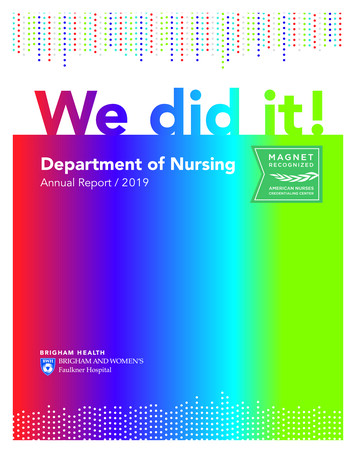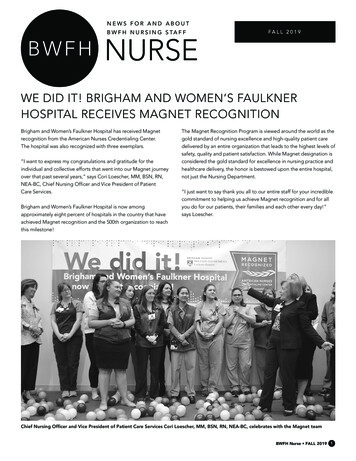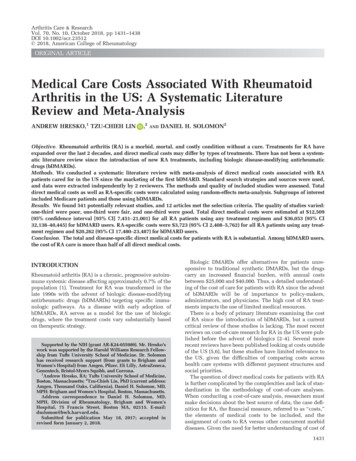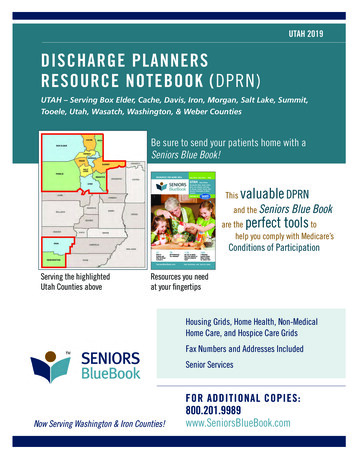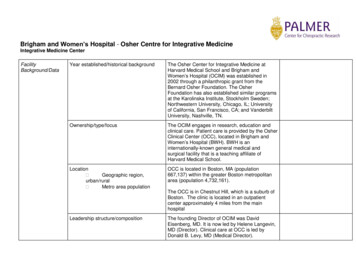
Transcription
Brigham and Women’s Hospital - Osher Centre for Integrative MedicineIntegrative Medicine CenterFacilityBackground/DataYear established/historical backgroundThe Osher Center for Integrative Medicine atHarvard Medical School and Brigham andWomen’s Hospital (OCIM) was established in2002 through a philanthropic grant from theBernard Osher Foundation. The OsherFoundation has also established similar programsat the Karolinska Institute, Stockholm Sweden;Northwestern University, Chicago, IL; Universityof California, San Francisco, CA; and VanderbiltUniversity, Nashville, TN.Ownership/type/focusThe OCIM engages in research, education andclinical care. Patient care is provided by the OsherClinical Center (OCC), located in Brigham andWomen’s Hospital (BWH). BWH is aninternationally-known general medical andsurgical facility that is a teaching affiliate ofHarvard Medical School.Location Geographic region,urban/rural Metro area populationOCC is located in Boston, MA (population667,137) within the greater Boston metropolitanarea (population 4,732,161).The OCC is in Chestnut Hill, which is a suburb ofBoston. The clinic is located in an outpatientcenter approximately 4 miles from the mainhospitalLeadership structure/compositionThe founding Director of OCIM was DavidEisenberg, MD. It is now led by Helene Langevin,MD (Director). Clinical care at OCC is led byDonald B. Levy, MD (Medical Director).
Size Beds/catchment/enrolleesDepartments/employeesBWH is a 757-bed facility with 45,352 admissionsin the most recent year reported. It includes 150outpatient practices with over 1,200 physicians.Revenue sources (private, Medicare,Medicaid)OCC sees a mixture of self-payment, insuranceand Medicare cases.Notable current initiatives/changes CAM, spine, pain/opiate Patient experienceResearch, education, and clinical care inintegrative medicine are featured aspects of theOsher integrative medicine program. Careerdevelopment for complementary and alternativemedicine providers are integrated into theprogram through the National Institutes of Health.Implementation ofImpetus/climate/backgroundchiropractic servicesOCIM was started to research integrative settingsand possibly to be replicated. Initially, there was asignificant resistance to including chiropracticservices. Much of this was related to uncertaintyabout safety of cervical manipulation in particular.The lead DC and Medical Director wereinstrumental in educating other stakeholders, thusovercoming the resistance.“We decided that achiropractor really wouldn't bepart of this if there was going tobe any limitation in the scopeof practice” (Provider)Planning process/timelineThe lead DC was identified by Dr. Eisenberg, and Of the center’s chiropractors starting in 2003 was invited to attend monthly“Dr. Eisenberg found the wholeplanning meetings at the OCIM. Later, a group of crew.” (Provider)16 or more planners, including representativesfrom the medical and chiropractic communities,met weekly for 14 weeks to discuss the integrativecenter.Year clinical services established2008
Chiropractic ClinicStructuresAdministration Department/service quipmentOCC is structured as a group practice with allservices overseen by the Medical Director.Two examination/treatment rooms are dedicatedfor chiropractic services. These are furnished withstate of the art chiropractic tables and othernecessary equipment.Currently 3 roomsChiropractors cal activitiesProfessional attributesInterprofessional attributesThree chiropractors are on staff at OCC. The leadDC is a full-time salaried employee and the othertwo DCs are part-time per diem employees.CURRENTLY 2 DCsPrivileges include full scope of clinical servicesconsistent with training and state licensure,although the facility follows Medicare guidelineswhich do not permit DCs to order advancedimaging in-house.The chiropractors describe themselves asdiversified, preforming numerous differenttreatments. A background working in or studyingin a medical setting is beneficial.The chiropractors expressed the need to have theability to communicate in a medical setting. Theneed for across specialty communication is vitalfor patient care.
Support staff Discipline/numberPatient access Referral, self-referralAppointment availability/waitAppointment length, number perweekRelevant partnerships Academic, researchOCC employs one medical assistant whoprovides clinical support to all providers asavailable. Administrative staff includes a practiceadministrator and a practice coordinator.The patient base is both referred from providers inthe hospital system and self-referred. The primarychiropractor expanded his schedule at the clinicallowing for increased patient appointmentavailability. Patient wait for a first appointment isusually under a week.If you’re looking to see achiropractor for the first timeyou are usually in some sort ofpain. So, the sooner thebetter. (Staff)OCC has just completed a large scale 3-year lowback pain study through BWH. Both chiropractorsare active in conducting clinical research.Clinicians from OCC participate in monthlyintegrative medicine ground rounds.Chiropractic ClinicProcessesPatient characteristics Population, conditions, complexityAccess patterns seenPatients can self-refer to various specialties at thefacility. Most chiropractic referrals are sent fromprimary care, HEADACHE NEUROLOGY and painmanagement. Cases span a range of complexity,and HEADACHE and post-operative spine patientsare common.Most chiropractic cases are covered by healthinsurance. The nuances of chiropractic billing andvariation in third party reimbursement practicespresent challenges to efficiency. Most of the otherintegrative services at the facility are cashpayment, which presents its own challenges sincethis is not typical for a hospital.Many patients do say, "Iwouldn't normally havepresented to the cornerchiropractic clinic but becauseyou’re at the Brigham, Brighamhas a great reputation." I thinkpatients come in with anelevated expectation of ourbackground, of our abilities, ifthey have a Brigham primarycare doctor sending them to achiropractor. (Provider)
Services provided Diagnostic, therapeuticFull scope diagnosis and management ofmusculoskeletal and neuromuscular conditions.This includes manual joint manipulation andmobilization, soft tissue therapies, and active careapproaches such as exercise and ergonomics.
Case management CPGs/care pathways usedOutcome assessment/reportingCommunication/collaboration withother rtments. Generally, providers report informalprocesses of face-to-face communication forcollaborative case management that they feel arevery effective. Primary care providers engage inshared decision making with patients regardingavailable treatment options, and chiropractic isoften the first choice for back pain casesThe massage is only going togo so far if the vertebrae arecompletely locked. If there’s adegree of complexity where Iwould like more feedback, thenI always refer to a chiropracticphysician. (Provider)Providers also communicate through the EMR asOne thing that’s really greatneeded, and through formal team meetings twiceabout being part of this clinic ismonthly.the ability to integrate care andGenerally, clinicians agree that time constraints to work with my chiropractorpose a barrier to between-provider communication. colleagues, which I now have. IYet they also feel that this barrier is overcome see them at the teamthrough collegial cooperation, and referring meetings, really thoughtful,providersfindcommunicationwiththe smart people who are lookingchiropractors to be appropriate and helpful.holistically and physiologicallyat why people are gettingheadaches. My impression forall the practitioners within thisgroup is that they’re . trying toprovide really good medicalcare and in an integrated wayand in a safe way in looking forevidence to do what they do.(Provider)
Impacts/OutcomesClinic function Use, utilization, performancebenchmarksMuch administrative and clinical data are availablebut not routinely analyzed or disseminated.Administrators are considering various processesfor increased formal reporting. The chiropracticclinic recently transitioned from part-time and perdiem chiropractors to its first full-time employee;consequently this current year will help developprovider and clinic benchmarksI have a feeling if all that painpatients came through here,we would do it cheaper. I thinkwe’d avoid half of the [moreexpensive treatments]. Wecould actually cut cost. Ifthere’s any capitated care, we’llwin.(Staff)Patient status Outcomes, satisfactionAll stakeholders expressed perceptions that clinical I always hear good thingsoutcomes are very favorable, and that patient about chiropractic.I thinksatisfaction is high.[medical providers] haveenough friends, or knowledge,or patients that say "that’s thebest, that works, I feel I canwalk," after whatevermanipulation they havereceived.(Staff)
System status Facility actual (or impression of)valueNon-DC staff impressionDC staff impressionPhysicians reported value in learning more aboutchiropractic care through their interactions andobservations in the chiropractic clinic. Positivechange in perception was noted by severalphysicians who, prior to working at this facility,previously had unfavorable experiences withchiropractors in the community.Interdisciplinary activities -- both formalpresentations and ad hoc encounters between thechiropractors and other providers at the facility –are valued. However formal interprofessionaleducation faces obstacles since information aboutchiropractic is typically not covered in medicalschool.If [patients] are getting relief ofpain [from chiropractic] they’reusing less analgesics. Noquestion about it.(Provider)I had a personalexperience I had someacute radicular lower backpain I was hobblingaround for a while and I said,well, I think I'll go downstairsand see what a chiropractordoes. What impressed mewas that just after somespinal manipulation sherelieved my pain and I waslike, wow, that was prettygood.(Provider)
Year established/historical background The Osher Center for Integrative Medicine at Harvard Medical School and Brigham and Women's Hospital (OCIM) was established in 2002 through a philanthropic grant from the Bernard Osher Foundation. The Osher Foundation has also established similar programs at the Karolinska Institute, Stockholm Sweden; Northwestern University, Chicago, IL; University

